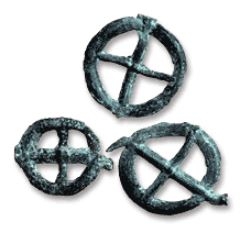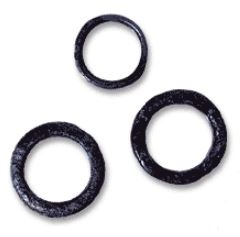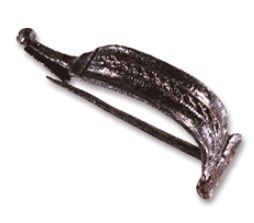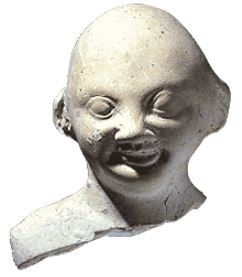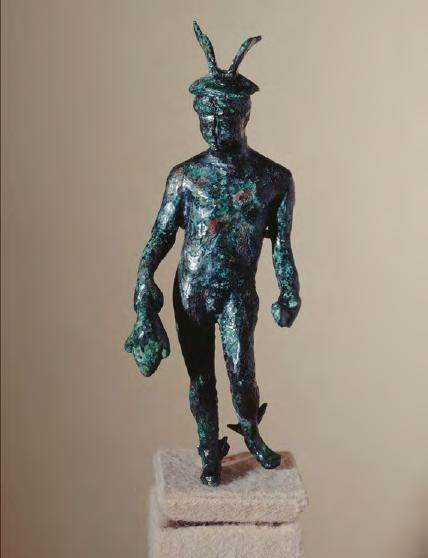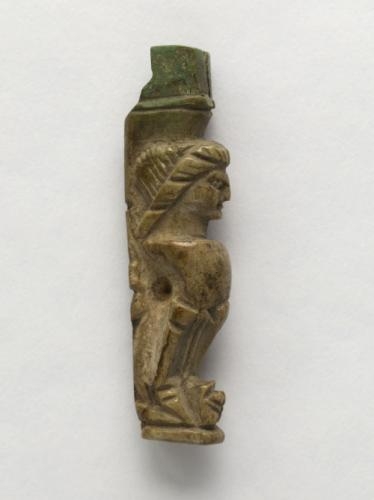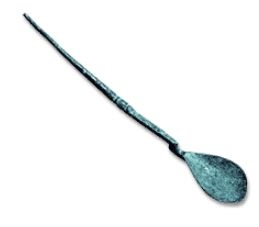- Home
- Aspects of the daily life
- Discoveries
Jewelry
Wheels.
These small wheels appear to be rejects because they were not trimmed of excess metal. It is difficult to determine if they were decorative elements or if they had a monetary value.
Lead.
Commission du Vieux Paris.
©M. Paturange / CVP.
Rings.
Early Roman.
Commission du Vieux Paris.
© M. Paturange / CVP.
Aucissa-type fibula.
The pin passed through a hole in the upturned foot, thus holding two lateral buttons in place. Moulded copper alloy with tin plating.
Augustan era.
Commission du Vieux Paris.
© CVP.
Aucissa-type fibula.
Aucissa-type fibula. Three ridges adorn the arch; the centre ridge is decorated with a broken line flanked by two filigrees. This piece was discovered in the very earliest habitation layer beneath the first houses. Along with two Augustan-era coins, it allowed archaeologists to date Lutetia's first urban construction phase.
Moulded copper allow.
Augustan era.
Commission du Vieux Paris.
©CVP.
Combined hinge and arch Aucissa-related fibula.
The décor and the size could mean that this is a late Empire fibula.
Moulded copper alloy.
Second half of the 1st century-second century.
Commission du Vieux Paris.
© CVP.
Cruciform fibula. The foot of the piece is decorated with a volute motif in relief, and the arch displays a delicate engraved border. One of the particularities of the decor is the presence of three small medallions, each bearing the bust of a person. It is possible that these depict the emperor Valentinian I (present in Paris in 366-367) and his sons. This exceptional piece probably belonged to one of the town's leading citizens or a high-ranking politician making an official visit to Lutetia.
Gold plate with engraved,
chiselled and nielloed decoration.
Late Roman, second half of the 4th century.
© Musée Carnavalet
Intaglio with Eros holding a crown in one hand, symbolising victory, and a hoe in the other.
Chrysoprasus.
First half of the 1st century.
Commission du Vieux Paris.
© Ch. Rapa /CVP.
Intaglio with a figure of a young woman holding a cup to her lips. She is Methe, a Maenad in Bacchus's entourage who protects drinkers from becoming intoxicated.
Chrysoprasus.
Early Roman.
Commission du Vieux Paris.
©Ch. Rapa /CVP.
Intaglio showing a cow and a goat.
Chrysoprasus.
Early Roman.
© Musée Carnavalet, Paris.
Belt buckle decorated with volutes. This may be from a Roman military uniform.
Copper allow.
Early Roman.
Commission du Vieux Paris.
© CVP.
Statuary
Risus
Hollow figurine of a bald, smiling infant made of white terracotta with a light ochre patina. The torso is missing but the figure probably ended in a triangle that rested on a circular base.
White terracotta.
H. 7 cm; l. 4,7 cm.
Early Roman.
Musée Carnavalet, Paris.
©M. Paturange / CVP.
Balsamarium.
Incense holder in the form of a young man's head.
Bronze.
Early Roman.
Musée Carnavalet, Paris.
©A.-B. Pimpaud.
Statuette of a lion, votive deposit.
White terracotta.
H. 8 cm ; l 3 cm.
2nd-3rd century CE.
Musée Carnavalet, Paris.
©C. Rapa / CVP.
Statuette of Mercury.
This statuette was found in a 3rd century ditch. The god is wearing a hat with wings, known as a pétase. This is the only depiction of Mercury found in Paris in which the god also has wings on his feet.
Bronze. H. 16,5 cm.
3rd century CE.
Musée Carnavalet, Paris.
© Philippe Ladet / Musée Carnavalet / Roger-Viollet
Statuette of a genius holding a patera in the right hand and a cornucopia in the left. This piece was discovered in a house that burned in the mid-3rd century.
Bronze.
H. 8 cm.
Musée Carnavalet, Paris.
© C. Rapa / CVP.
Statue of Rosmerta
Gallic diviny who's attributes (the caduceus and the fruit basket) evoke the Latin Fortuna. The statue was discovered in the filling of an underground room, with a statue of Mercury and architectural blocks.
Shell limestone.
H. 91 cm; l. 20 cm.
Musée Carnavalet, Paris.
©J.-L. Godard / CVP.
Statue of Mercury
Shell limestone.
H. 60 cm ; l. 33,5 cm.
Musée Carnavalet, Paris.
©J.-L. Godard / CVP.
Knife handle.
This handle, carved from bone, features a sphinx.
Bone, copper alloy, iron.
L. 5, 7 cm ; w. 1,3 cm ; diameter 0,75 cm.
3rd century.
Musée Carnavalet, Paris.
© Stéphane Piera / Musée Carnavalet / Roger-Viollet
Tools and instruments
Medical or grooming tools.
These implements have circular or polygonal handles, and the ends are either lobed or consist of variously-shaped spatulas.
Copper allow.
Length: from 11.3 to 16.5 cm.
Early Roman.
Commission du Vieux Paris.
©M. Paturange / CVP.
Spoon
Copper alloy.
L. 12,5 cm.
2nd century CE.
Commission du Vieux Paris.
©M. Paturange / CVP.
Game pieces
Games such as backgammon, latrunculi (a game similar to chess played on a checkerboard), tabulae lusoriae (like checkers) were very popular throughout the Roman era and a number of game pieces have been found. The fanciest pieces were made of carved wood or glass, but there are no less than 33 made out of pieces of common ceramic ware. Pieces with counting marks on them may have something to do with the game in which they were used.
Gaming pieces. A bone piece decorated with concentric circles, a triangular piece with a circle in the center, rounded pieces with flat bases created in a mould.
Bone and glass paste.
Early Empire.
Commission du Vieux Paris.
© M. Paturange / CVP.
Try-square
Reconstruction of a ancient try-square, bronze fragments of which were discovered in a well in the Luxembourg Garden.
Bronze and wood.
H. 25 cm ; L. 48 cm ; sides 36 cm.
3rd century CE.
Musée Carnavalet, Paris.
©C. Rapa / CVP.
